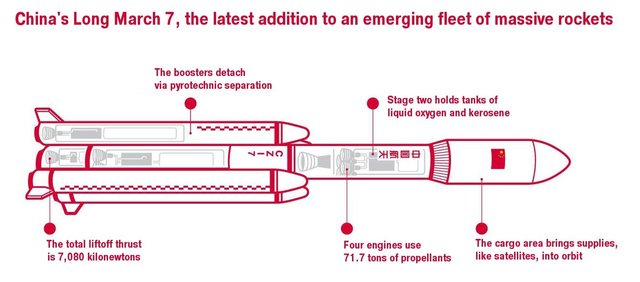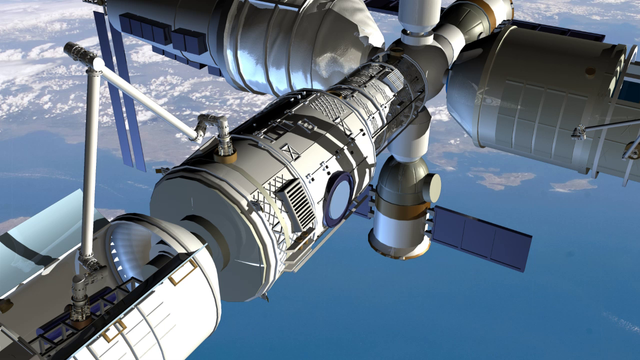China's Race to Space Domination: To Try to Gain an Edge Here on Earth, China is Pushing Ahead in Space
Before this decade is out, humanity will go where it’s never gone before: the far side of the moon. This dark side — forever facing away from us — has long been a mystery. No human-made object has ever touched its surface. The mission will be a marvel of engineering. It will involve a rocket that weighs hundreds of tons (traveling almost 250,000 miles), a robot lander, and an unmanned lunar rover that will use sensors, cameras, and an infrared spectrometer to uncover billion-year-old secrets from the soil. The mission also might scout the moon’s supply of helium-3 — a promising material for fusion energy. And the nation planting its starry flag on this historic trip will be the People’s Republic of China.

After years of investment and strategy, China is well on its way to becoming a space superpower — and maybe even a dominant one. The Chang’e 4 lunar mission is just one example of its scope and ambition for turning space into an important civilian and military domain. Now, satellites guide Chinese aircraft, missiles, and drones, while watching over crop yields and foreign military bases. The growing number of missions involving Chinese rockets and taikonauts are a source of immense national pride.
“China sees space capability as an indication of global-leadership status,” says John Logsdon, founder of the Space Policy Institute at George Washington University. “It gives China legitimacy in an area that is associated with great power.”
China’s estimated space budget is still dwarfed by NASA’s, which is $19.3 billion for this year alone. But China’s making the most of its outlay. This past year, it had 19 successful space launches — the second-highest number behind Russia’s 26, and ahead of America’s 18. The decades ahead will see a range of Chinese missions that will match — and maybe even surpass— previous NASA exploits, including quantum communications satellites and a crewed mission to the moon in the early 2030s.
By landing on the moon, China isn’t just joining an exclusive two-nation club. It is also redefining what space means —militarily, economically, and politically — in the 21st century. There are plans for heavy-lift rockets, manned space stations, and one of the world’s largest satellite-imaging and -navigation networks. Meanwhile the U.S. — particularly where human spaceflight is concerned — is hardly moving at all. “I don’t worry about China suddenly leapfrogging us,” says James Lewis, a director at the Center for Strategic and International Studies, a D.C. think tank. “I worry about us being distracted and waking up to realize that they have a much more powerful position in space.”
As in the U.S. space marketplace, China relies on many state-linked aerospace companies working with its China National Space Administration (CNSA) to perform a dual role of supporting its military. There’s the Aerospace Science and Technology Corporation (the primary contractor for building spacecraft), its Academy of Launch Vehicle Technology subsidiary (which helps design the nation’s so-called Long March rockets), the Academy of Space Technology (designing many of China’s satellites), and the Aerospace Science and Industry Corporation, a defense contractor that builds items like the atomic clocks on navigation satellites.
Such interconnectedness goes back to the beginnings of China’s rocket age and, ironically, to American soil. The man considered the father of Chinese rocketry is Qian Xuesen. A Chinese national, Qian had attended MIT in 1935, went to work on the Manhattan Project, and later became a co-founder of Caltech’s famed Jet Propulsion Laboratory. But during the Joseph McCarthy era, he was accused of being a communist sympathizer, put under house arrest for five years, and, in 1955, he returned to China. There he was greeted as a hero. He later developed China’s ballistic-missile and space-rocket programs. In fact, China still relies on the Long March rockets he helped develop to launch its space systems.

Starting in the ’80s, China put up sophisticated communications and intelligence satellites, and offered cheap satellite launch services to other nations. It began a taikonaut (a mashup of the Mandarin word for “outer space” and “naut,” which is Greek for “sailor”) training program, and started building out manned mission capsules and space planes. With the launch of its manned Shenzhou 5, which carried taikonaut Yang Liwei into space for 21 hours in 2003, China’s space race began to hit its marks. From there, China made rapid leaps: multiple crewed missions, spacewalks, and, in 2011, the launch of Tiangong-1, a two-person space lab. Early next year, it will launch its first-generation cargo ship, Tianzhou-1, which means “ heavenly vessel.” The ship will dock with an existing Chinese space lab and bring supplies for science experiments.
If any of this sounds like a repeat of feats already accomplished decades ago by others (U.S. and Soviet Union), that glib observation falls to pieces when you consider technologies like China’s QUESS satellite — which will likely be orbiting overhead by the time you read this. Short for Quantum Experiments at Space Scale, QUESS marks a first-of-its-kind attempt to beam quantum-encrypted information between an orbiting satellite and ground stations below. By encoding that information into the quantum states of particles like photons, such security schemes ensure that any attempt to intercept or tamper with the transmission alerts both sender and receiver, making quantum encryption theoretically unbreakable.
In an era of global electronic surveillance, a quantum-communications network could sidestep even the best cyberintelligence operations, allowing Chinese military and intelligence assets to swap information while keeping potential adversaries or spies in the dark. As long as China is the only nation bouncing quantum communications around the atmosphere, it will enjoy scientific and strategic security advantages, as well as a boost to economic security: QUESS researchers say that a long-term goal is the protection of financial communications.
China’s rising space prowess has, predictably, come with geopolitical friction between Beijing and Washington. While the nations have deep levels of trade with each other, they also eye one another as a security threat. In fact, China’s space program is repeatedly cited in U.S. security reports with a growing sense of unease. As the U.S. and Soviet Union learned in the 1960s and ’70s, showcasing capability in space often translates to influence on the ground. The military benefits of going to the moon are zero, but the geopolitical effects are real. “China’s going to get back to the moon before we do; they’re going to have people walking around on another body, and we’re not,” Lewis says. “Right now the U.S. is seen as the leader in space, but we’re kind of resting on our laurels. So what happens when the rest of the world wakes up and realizes that China is the leader?”
That means China’s heavenly rise could realign partnerships in space. With its steady drumbeat of near-term mission milestones and concrete objectives (as opposed to a vague trip to Mars), the CNSA “gives a lot of countries a nice opportunity to develop new partnerships to stay active in space exploration,” says Alanna Krolikowski, an expert in Chinese technology policy and a visiting professor at the University of Göttingen in Germany.
China is also playing geopolitics with nation states that aren’t always willing to be aligned with Washington’s selfinterests. It has been offering cheap and easy access to space, launching satellites for countries like Venezuela, Laos, Nigeria, and Belarus. Pakistan has used China’s military-grade satellite-navigation system, suggesting that China will also allow use of space-derived intelligence as part of future alliance building.

And if it continues its pace, China will launch its experimental Tiangong-2 space lab later this year, followed by a crew that will dock there and test technologies critical for building a permanent manned outpost in orbit. The first module of that outpost — Tiangong-3 — is China’s highest profile project. It is expected to lift off in 2022, marking a new era of Chinese space research. Tiangong-3 will be able to support three taikonauts, in addition to a bevy of scientific research. Notably, CNSA has already rolled out the welcome mat to other countries, offering the opportunity to place experiments, and astronauts, aboard. Given a Congressional ban that prohibits NASA from cooperating with the CNSA in space, it’s unlikely the U.S. will be among them. But many of America’s current partners in space very well might. After all, if the U.S. and co-owners shutter the expiring International Space Station in 2024 as planned, China will be the only country up there.
Just as in the Cold War, there is also the possibility that space activities could yield more peace, not less. As China’s military and civilian dependence on space begins to mirror that of America’s, the hazard-filled nature of space operations creates an incentive for both nations — along with other space actors — to a maintain at least an uneasy cooperation. Global reliance on the space-based communications and navigation that power our digital age means that America and China will have to work together to draw up the rules for the crowded new space age. After all, the solar system is our communal turf. At least for now.
Great read. Interesting to think about how the massive increase in Chinese military spending also correlates with their increase in spending with regards to space programs. Really does look like another cold war. Perhaps we will see Putin cosy up to China more in the coming years.